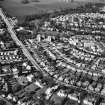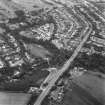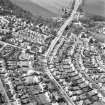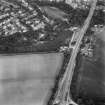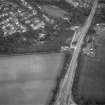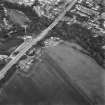Pricing Change
New pricing for orders of material from this site will come into place shortly. Charges for supply of digital images, digitisation on demand, prints and licensing will be altered.
Edinburgh, Cramond, Brae Park Road, Cramond Old Bridge
Road Bridge (15th Century)
Site Name Edinburgh, Cramond, Brae Park Road, Cramond Old Bridge
Classification Road Bridge (15th Century)
Alternative Name(s) Cramond Brig Toll; River Almond
Canmore ID 50389
Site Number NT17NE 1
NGR NT 17950 75466
Datum OSGB36 - NGR
Permalink http://canmore.org.uk/site/50389
- Council Edinburgh, City Of
- Parish Dalmeny
- Former Region Lothian
- Former District City Of Edinburgh
- Former County West Lothian
NT17NE 1 17950 75466
(NT 1795 7546) Cramond Old Bridge (NR)
OS 6" map (1968)
For (successor) Cramond New Bridge (adjacent to SW), see NT17NE 282.
REFERENCE:
Country Life, 9th July, 1943 - photograph and information
(Undated) information in NMRS.
Cramond Old Bridge, still in use and in good condition in 1953, is probably of late 15th-early 16th century date. Part of the bridge fell sometime before 1587, but it is recorded on the parapet that it was rebuilt by 1619 and repaired in 1687, 1761, 1776 and 1854. There are three arches, the oldest being the western one.
Visited by OS (JLD) 1 December 1953
RCAHMS 1929, visited 1920
This bridge is as described and now in use as a footbrige only.
Visited by OS (BS) 11 December 1975.
Cramond Old Bridge, Brae Park Road. c. 1500, heavily repaired in 1617-19, and again by Robert Mylne, 1687-91. Further repairs 1761, 1776 and 1854. Three obtusely-pointed arches with a string course jumping over them. Heavy triangular cutwaters.
J Gifford, C McWilliam and D Walker 1984.
As a condition of Scheduled Monuments Consent a watching brief was carried out during the digging of three test pits to assess the viability of laying a new gas main across the bridge which was originally constructed in c1500. A pit was dug over the centre of each bridge arch to determine he depth of cover. All pits were 1m square and dug in the centre of the carriageway. In the N pit a sequence of 5/6 old road surfaces overlay the sandstone arch structure, 0.44m below ground surface. The centre pit cut through a similar sequence of road surfaces to a depth of 0.60m, at which level was a surface of substantial black rounded cobbles, most likely marking the old county boundary which ran along this line. In the S pit, the old road surfaces had been scalped off and the modern tarmac and make-up lay directly over the bridge structure at a depth of 0.18m.
Sponsor: British Gas (Scotland) plc.
M Collard 1992.
Now a footbridge, this bridge formerly carried the A90 public road across the River Almond on the NW fringe of suburban Edinburgh; it thus allowed access from Edinburgh to South Queensferry and the Forth crossing. It was replaced in about 1964 by Cramond New Bridge (NT17NE 282), to the SW.
The river here forms the boundary between the parishes of Dalmeny (to the W) and Edinburgh (to the E).
Information from RCAHMS (RJCM), 8 March 2006.
Construction (1488)
Field Visit (4 November 1920)
Cramond Old Bridge.
The river Almond, which divides the county of Midlothian from West Lothian, is crossed, rather more than a mile above its mouth, by a fine medieval stone bridge (Fig. 22 [SC 1124586]), which carried the Edinburgh to Stirling highway until a modem bridge was built 130 yards farther up the stream. It is not definitely known when the bridge was first erected, but the detail of the western portion is suggestive of late 15th- or early 16th century work. A portion of the bridge fell some time before 1587 (1), but inscriptions on the parapet record that it was rebuilt by 1619 (2) and repaired in 1687, 1761, 1776, and 1854. There are three pointed segmental arches with salient cut-waters on the intermediate piers. The western arch is the oldest and has four massive soffit ribs; the outer face of this arch is in two orders, both, like the ribs, chamfered. The other arches are without ribs. The north-western cut-water, unlike the other three, which have pyramidal tops, terminates in a sloped tabling. A drip-mould of circa 16th-century date returns horizontally; it breaks and returns over each arch. Throughout, the structure is of light-coloured ashlar, which has weathered well and is in good preservation. Across the parapets the bridge measures 15 feet 11 inches, and the roadway is 13 feet 7 ½ inches wide. The outer arches have nearly the same span, viz. 40 feet, while the centre arch is 36 feet 8 inches wide. The parapet is 22 ¼ feet above the water and 3 feet above the roadway. The south parapet bears inscriptions as under:
(a) In raised lettering within a recessed panel, ‘Anno dom. 1619’; (b) similarly executed, but on the south or outward face of the same stone, the date ‘1619’; (c) incised, ‘Repaired be both sheires 1687’; (d) incised, ‘Repaired by both shires 1761 and again in 1776’; (e) incised, ‘Repaired by both shires 1854’.
RCAHMS 1929, visited 4 November 1920.
(1) Acts Parl. Scot., iii, p. 519; (2) The building of a new bridge was determined upon in 1607. Ibid iv, p. 397.
Photographic Survey (May 1965)
Photographic survey by the Scottish National Buildings Record/Ministry of Work in May 1965.
Watching Brief (1992)
As a condition of Scheduled Monuments Consent a watching brief was carried out during the digging of three test pits to assess the viability of laying a new gas main across the bridge which was originally constructed in c1500. A pit was dug over the centre of each bridge arch to determine he depth of cover. All pits were 1m square and dug in the centre of the carriageway. In the N pit a sequence of 5/6 old road surfaces overlay the sandstone arch structure, 0.44m below ground surface. The centre pit cut through a similar sequence of road surfaces to a depth of 0.60m, at which level was a surface of substantial black rounded cobbles, most likely marking the old county boundary which ran along this line. In the S pit, the old road surfaces had been scalped off and the modern tarmac and make-up lay directly over the bridge structure at a depth of 0.18m.
Sponsor: British Gas (Scotland) plc.
M Collard 1992.
Project (2007)
This project was undertaken to input site information listed in 'Civil engineering heritage: Scotland - Lowlands and Borders' by R Paxton and J Shipway, 2007.
Publication Account (2007)
The three-span mediaeval masonry bridge spanning the Almond dates originally from ca.1488. Only the westernmost of its original pointed arches remains, which has four ribs bridged by stone slabs. The roadway width between parapets is 1312 ft. The other two arches, destroyed by a flood in 1587, were rebuilt in 1619 as vaulted arches, also pointed. The spans are unusual, being 37 ft for the centre span and 40 ft for the two outer spans. The two upstream and the east downstream cutwaters are of one design and probably date from 1619, but the west downstream cutwater looks older and may be original. The inner face of the upstream parapet bears several dates in the 18th and 19th centuries when repairs were carried out. Its outer face bears the date 1619.
Cramond Brig appears to have been the only bridge over the Almond at this location until 1820, when increasing traffic on the Queensferry road required a new bridge.
R Paxton and J Shipway 2007
Reproduced from 'Civil Engineering heritage: Scotland - Lowlands and Borders' with kind permission of Thomas Telford Publishers.
Watching Brief (6 May 2014 - 15 October 2014)
AOC Archaeology Group was commissioned by the City of Edinburgh Council to undertake a series of archaeological works in advance of, during and after the renovations at Cramond Old Brig, Edinburgh. The work included both before and after photographs of the bridge after consolidation work was carried out as well as a watching brief on the excavation of a number of test pits on the surface of the bridge to identify the extent and survival of the drainage spouts.
Information from Diana Sproat (AOC Archaeology Group) October 2014. OASIS ID: aocarcha1-190712

















































